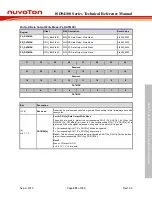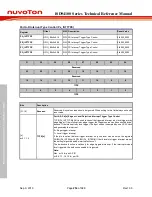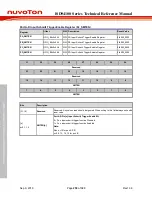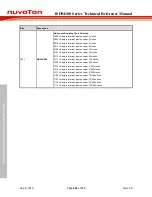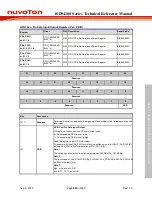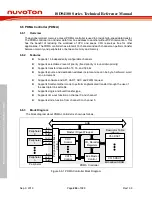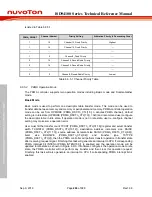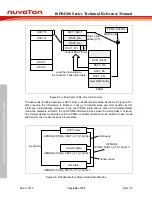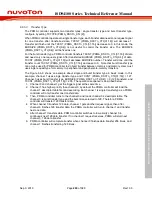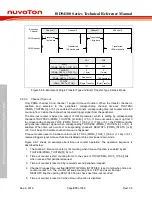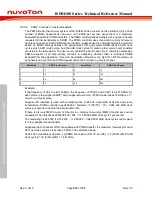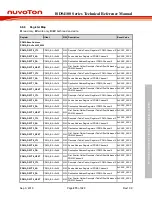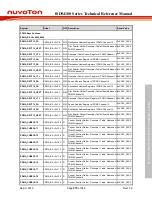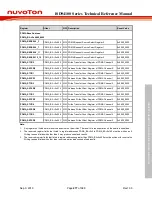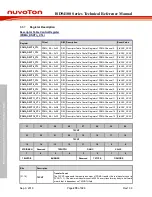
ISD94100 Series Technical Reference Manual
Sep 9, 2019
Page
265
of 928
Rev1.09
IS
D
9
410
0
S
ER
IE
S
T
E
C
HN
ICA
L
RE
F
E
RE
NCE
M
AN
U
AL
6.6.4
Basic Configuration
Clock source configuration
–
Enable PDMA controller clock in PDMACKEN (CLK_AHBCLK [1]).
Reset configuration
–
Reset PDMA controller in PDMARST (SYS_IPRST0[2]).
6.6.5
Functional Description
The PDMA controller transfers data from one address to another without CPU intervention. The
PDMA controller supports 16 independent channels and serves only one channel at one time, as
the result, PDMA controller supports two level channel priorities: fixed and round-robin priority,
PDMA controller serves channel in order from highest to lowest priority channel. The PDMA
controller supports two operation modes: Basic mode and Scatter-gather mode. Basic mode is used
to perform one descriptor table transfer. Scatter-gather mode has more entries for each PDMA
channel, and thus the PDMA controller supports sophisticated transfer through the entries. The
descriptor table entry data structure contains many transfer information including the transfer
source address, transfer destination address, transfer count, burst size, transfer type and operation
mode. The Figure 6.6-2 shows the diagram of descriptor table (DSCT) data structure.
.
.
.
Descriptor Table
DSCT15
DSCT14
DSCT1
DSCT0
DSCT_DA
DSCT_NEXT
Descriptor Table Entry Structure
0x0C
0x08
0x04
DSCT_SA
DSCT_CTL
0x00
0x00
DSCT2
DSCT3
DSCT5
DSCT4
0x10
0x20
0x30
0x40
0x50
0xE0
0xF0
.
.
.
DSCT13
0xD0
Figure 6.6-2 Descriptor Table Entry Structure
PDMA controller also supports single and burst transfer type and the request source can be from
software or peripheral request, transfer between memory to memory using software request. A
single transfer means that software or peripheral is ready to transfer one data (every data needs
one request), and the burst transfer means that software or peripherals will transfer multiple data
(multiple data only need one request).
6.6.5.1
Channel Priority
The PDMA controller supports two level channel priorities including fixed and round-robin priority.
The fixed priority channel has higher priority than round-robin priority channel. If multiple channels
are set as fixed or round-robin priority, the higher channel will have higher priority. The priority order

